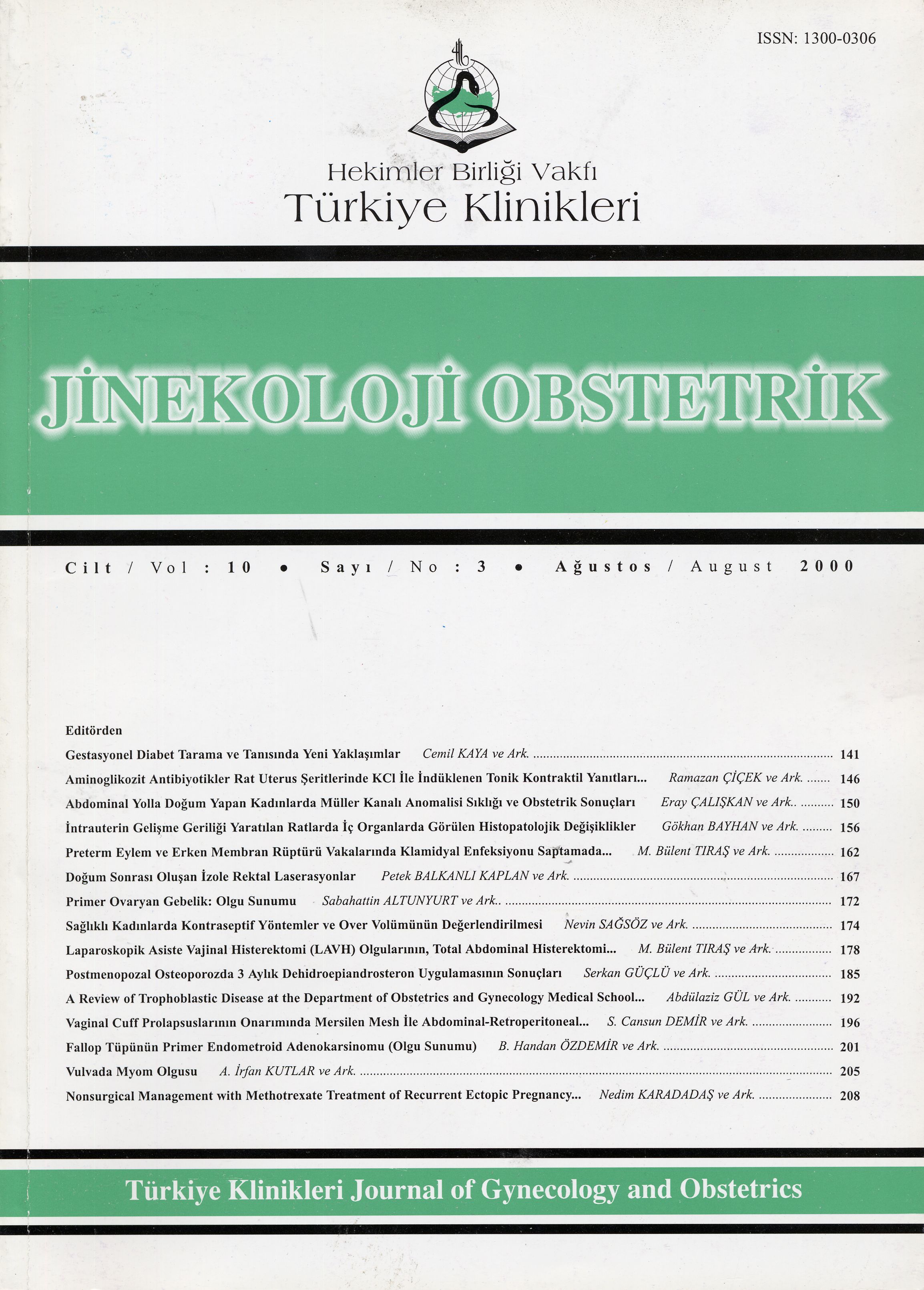Open Access
Peer Reviewed
ARTICLES
3459 Viewed1210 Downloaded
The Role of Dehydroepiandrosteron Administration for Three Mounths on Postmenopausal Osteoporosis
Postmenopozal Osteoporozda 3 Aylık Dehidroepiandrosteron Uygulamasının Sonuçları
Turkiye Klinikleri J Gynecol Obst. 2000;10(3):185-91
Article Language: TR
Copyright Ⓒ 2025 by Türkiye Klinikleri. This is an open access article under the CC BY-NC-ND license (http://creativecommons.org/licenses/by-nc-nd/4.0/)
ÖZET
Amaç: Dehidroepiandrosteron (DHEA) uygulamasının serum interleukin-6 (IL-6) düzeyleri ve osteoporoz üzerine olan etkilerini değerlendirmek. Materyal ve Metod: 60 postmenopozal hastada östrojen-pro-gesteron replasman tedavisi (HRT) ile, DHEA uygulaması karşılaştırıldı. Bu kıyaslama sırasında postmenopozal kadınlardaki DHEA kullanımının, trigliserid (TG), total kolesterol (TK), HDL, LDL, IL-6, alkalen fosfataz (AP), tartarat rezistan asit fosfataz (TRAP) düzeyleri ile osteoporoz üzerine olan etkileri incelenmiştir. Sonuçlar: DHEA verilen grupta tedavi öncesi ortalama serum IL-6 düzeyi 3.45±1.2 pg/ml iken DHEA sonrası 2.68±1.2ye düşmüştür (p<0.05). HRT verilen grupta ise serum ortalama TRAP düzeyleri tedavi öncesinde 3.26±0.2U/L iken tedavi sonrası anlamlı olarak azalmış ve 3.07±0.2U/Lye düşmüştür (p<0.05). DHEA grubunda tedavi öncesi ve sonrası serum TRAP değerleri sırasıyla 3.26±0.26U/L ve 3.09±0.22U/L saptanmış ve aradaki fark anlamlı bulunmuştur (P<0.05). Tartışma: DHEA tedavisinin östrojen tedavisiyle kombine bir şekilde uygulanması östrojenin antiosteoporotik etkilerini arttırırken, ayrıca effektif östrojen dozunun daha da azalmasına yol açabilir. Böylece östrojen dozunun düşmesi östrojene bağlı gelişen yan etki ve komplikasyonların azalmasına ve östrojen replasmanının daha güvenli bir şekilde yapılmasına olanak verir.
Amaç: Dehidroepiandrosteron (DHEA) uygulamasının serum interleukin-6 (IL-6) düzeyleri ve osteoporoz üzerine olan etkilerini değerlendirmek. Materyal ve Metod: 60 postmenopozal hastada östrojen-pro-gesteron replasman tedavisi (HRT) ile, DHEA uygulaması karşılaştırıldı. Bu kıyaslama sırasında postmenopozal kadınlardaki DHEA kullanımının, trigliserid (TG), total kolesterol (TK), HDL, LDL, IL-6, alkalen fosfataz (AP), tartarat rezistan asit fosfataz (TRAP) düzeyleri ile osteoporoz üzerine olan etkileri incelenmiştir. Sonuçlar: DHEA verilen grupta tedavi öncesi ortalama serum IL-6 düzeyi 3.45±1.2 pg/ml iken DHEA sonrası 2.68±1.2ye düşmüştür (p<0.05). HRT verilen grupta ise serum ortalama TRAP düzeyleri tedavi öncesinde 3.26±0.2U/L iken tedavi sonrası anlamlı olarak azalmış ve 3.07±0.2U/Lye düşmüştür (p<0.05). DHEA grubunda tedavi öncesi ve sonrası serum TRAP değerleri sırasıyla 3.26±0.26U/L ve 3.09±0.22U/L saptanmış ve aradaki fark anlamlı bulunmuştur (P<0.05). Tartışma: DHEA tedavisinin östrojen tedavisiyle kombine bir şekilde uygulanması östrojenin antiosteoporotik etkilerini arttırırken, ayrıca effektif östrojen dozunun daha da azalmasına yol açabilir. Böylece östrojen dozunun düşmesi östrojene bağlı gelişen yan etki ve komplikasyonların azalmasına ve östrojen replasmanının daha güvenli bir şekilde yapılmasına olanak verir.
ABSTRACT
Objective: To evaluate the effect of Dehydroepiandrosteron (DHEA) administration on serum interleukin-6 (IL-6) levels and osteoporosis. Material and Methods: We compared the administration of DHEA and estrogen-progesterone replacement therapy (HRT) in 60 healthy postmenopausal patients. During this comparison, the effect of DHEA therapy on triglyceride (TG), total cholesterol (TC), HDL-C, LDL-C, IL-6, alkalene phosphatase (AP) and tartarat resistant acid phosphatase (TRAP) levels and osteoporosis in postmenopausal women were evaluated. Results: In patients who were given DHEA, mean serum IL-6 level after treatment was decreased from 3.45±1.2 pg/ml to 2.68±1.2 pg/ml (p<0.05). In patients who were HRT, mean serum TRAP levels after the treatment were decrased from 3.26±0.2U/L to 3.07±0.2U/L (p<0.05). In DHEA group, mean serum TRAP levels before and after the treatment were 3.26±0.2U/l and 3.09±0.22U/l respectively. The difference between mean serum TRAP levels was statistically significant (p<0.05). Conclusion: Combined DHEA and estrogen application not only would increase the antiosteoporotic effects of estrogen, but also would decrease the effective estrogen dose needed. The decline in estrogen dose could decrease the adverse effects and the complications of estrogens as well and thus estrogen replacement therapy would be safer.
Objective: To evaluate the effect of Dehydroepiandrosteron (DHEA) administration on serum interleukin-6 (IL-6) levels and osteoporosis. Material and Methods: We compared the administration of DHEA and estrogen-progesterone replacement therapy (HRT) in 60 healthy postmenopausal patients. During this comparison, the effect of DHEA therapy on triglyceride (TG), total cholesterol (TC), HDL-C, LDL-C, IL-6, alkalene phosphatase (AP) and tartarat resistant acid phosphatase (TRAP) levels and osteoporosis in postmenopausal women were evaluated. Results: In patients who were given DHEA, mean serum IL-6 level after treatment was decreased from 3.45±1.2 pg/ml to 2.68±1.2 pg/ml (p<0.05). In patients who were HRT, mean serum TRAP levels after the treatment were decrased from 3.26±0.2U/L to 3.07±0.2U/L (p<0.05). In DHEA group, mean serum TRAP levels before and after the treatment were 3.26±0.2U/l and 3.09±0.22U/l respectively. The difference between mean serum TRAP levels was statistically significant (p<0.05). Conclusion: Combined DHEA and estrogen application not only would increase the antiosteoporotic effects of estrogen, but also would decrease the effective estrogen dose needed. The decline in estrogen dose could decrease the adverse effects and the complications of estrogens as well and thus estrogen replacement therapy would be safer.
MENU
POPULAR ARTICLES
MOST DOWNLOADED ARTICLES





This journal is licensed under a Creative Commons Attribution-NonCommercial-NoDerivatives 4.0 International License.










